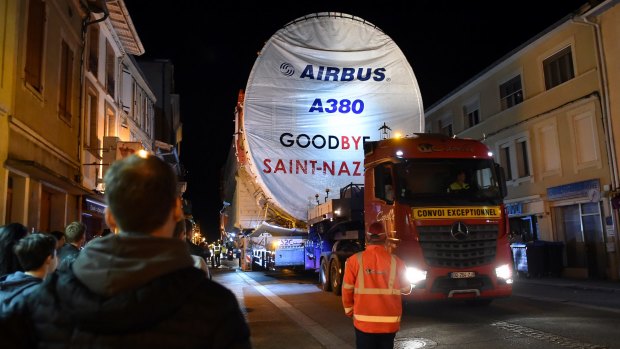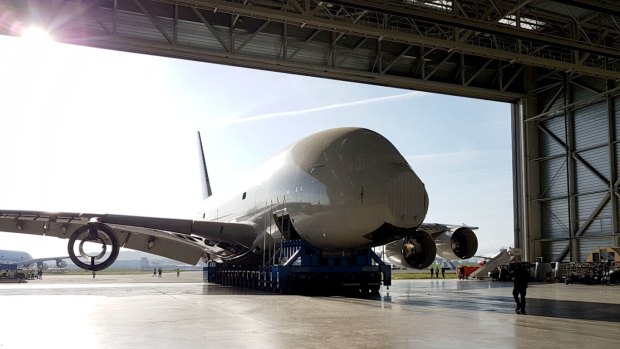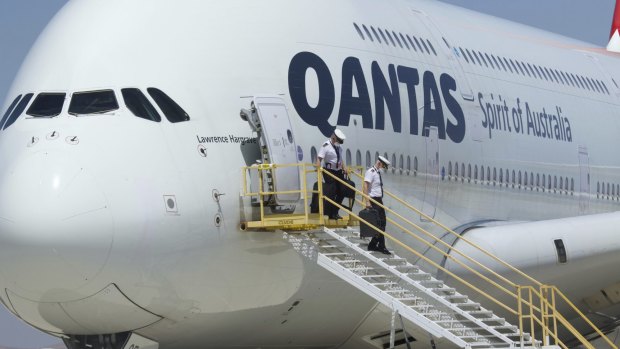This was published 3 years ago
Airbus A380: Parts for the last superjumbos move to final assembly in Toulouse
By Craig Platt

The last convoy of the Airbus A380 drives through Levignac, France.Credit: AFP
The era of large passenger planes is rapidly coming to an end as the construction of the final Airbus A380 superjumbos nears completion at the company's assembly plant in Toulouse, France.
The fuselage of the last A380s last month made their way through the small French village of Levignac, the final time the convoy will carry the giant aircraft's parts through the town.
"It has made the region live, together with all the villages round here and the people who built it. It's magnificent," Christiane Inard, who has watched almost 300 convoys creep past her living room since the first in 2004 told Reuters.

The world's first Airbus A380 has been dismembered for spare parts like engines and aeronautic components.Credit: Tarmac Aerosave
"It hurts my stomach seeing something stop just like that; it's difficult for employment, for the young people," Inard said.
One truck bore the sign "Goodbye Saint-Nazaire," the name of the French plant where some sections are pre-assembled.
"It was hard," said Peggy Jounier, 41, who placed the red nose on the last front section in Saint-Nazaire.

Qantas pilots leave an Airbus A380 after it arrived at Southern California Logistics Airport for storage. Credit: AP
The decline of the superjumbo, the largest passenger aircraft of all time, happened more quickly than Airbus had expected.
The plane launched to massive fanfare in 2007 with first customer Singapore Airlines. Its first commercial flight was from Singapore to Sydney on October 25 that year.
The A380 was a revelation in air travel - capable of carrying more than 500 passengers in a typical three-class layout, with certification for up to 853 passengers in an all-economy layout (something that some airlines raised the prospect of, but never implemented).
Airlines such as Singapore Airlines, Emirates and Etihad used the size of the superjumbo to create never-before-seen luxuries on board for passengers in the pointy end. Singapore Airlines introduced private suites for its first class passengers, including seats that converted into double beds. Emirates provided a shower in its first-class bathroom, while Etihad created "The Residence" - a three room suite at the front of first class, featuring a lounge, bedroom and private bathroom, complete with personal butler service.
But, despite these impressive features, along with popularity with passengers, as early as 2013, sales had already slumped, with Airbus failing to receive a single firm order for the plane that year.
Only six years later, as smaller and more fuel-efficient planes like the Boeing 787 Dreamliner and the Airbus A350 became more cost-effective options for airlines, Airbus announced it would halt production of the superjumbo.
In 2019, the first A380 ever built moved to an aircraft storage facility in France. It has since been dismantled for parts and scrap.
The advent of the COVID-19 pandemic has seen most airlines with superjumbos ground the large aircraft, as demand for air travel has plummeted. Qantas chief executive Alan Joyce said Qantas' fleet of 12 A380s would be grounded for three years, until international travel recovers. The planes are currently being stored at an aircraft "boneyard" in California.
The rise and fall of the A380 seems particularly rapid since its key rival, the Boeing 747 jumbo jet, has enjoyed more than 50 years as the workhorse of long-haul travel.
But the 747 has fallen victim to the same pressures as the A380, with most airlines - including Qantas - retiring their jumbo jets. The latest model, the 747-8, sold to just a few carriers.
In early July, Bloomberg reported that the 747, which Boeing has continued production of due to demand for the freighter version, is likely to cease production in two years. Qantas' last jumbo jet will perform a series of farewell flights next week.
The final Airbus A380 to be built, registration A6-EVS, is set to be delivered to Emirates, but this is currently under a cloud. Emirates has reportedly attempted to cancel the delivery of its final five A380s. Airbus has objected since the planes are already under construction.
See also: Farewell, jumbo: Qantas announces final flights for last 747
See also: The world's first A380 superjumbo broken up, recycled as luggage tags
Sign up for the Traveller newsletter
The latest travel news, tips and inspiration delivered to your inbox. Sign up now.